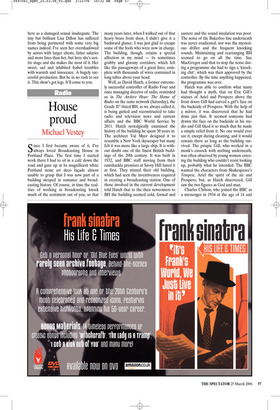House proud
Michael Vestey
Sce I first became aware of it, I’ve inalways loved Broadcasting House in Portland Place. The first time I started work there I had to sit in a café down the road and gaze up at its magnificent white Portland stone art deco façade almost unable to grasp that I was now part of a building steeped in romance and broadcasting history. Of course, in time the realities of working in broadcasting knock much of the sentiment out of you, so that many years later, when I walked out of that heavy brass front door, I didn’t give it a backward glance. I was just glad to escape some of the fools who were now in charge. The building, though, retains a special affection in my mind — its sometimes grubby and gloomy corridors, which felt like the passageways of a great liner, complete with thousands of wires contained in long tubes above your head.
Well, as David Hatch, a former extremely successful controller of Radio Four and once managing director of radio, reminded us in The Archive Hour: The Home of Radio on the same network (Saturday), the Grade II*-listed BH, as we always called it, is being gutted and reconstructed to take radio and television news and current affairs and the BBC World Service by 2011. Hatch nostalgically examined the history of the building he spent 30 years in. The architect Val Myer designed it to resemble a New York skyscraper but many felt it was more like a large ship. It is without doubt one of the finest British buildings of the 20th century. It was built in 1932, and BBC staff moving from their ramshackle premises at Savoy Hill hated it at first. They missed their old building, which had seen the inventiveness required in creating a broadcasting station. One of those involved in the current development told Hatch that to the then newcomers to BH the building seemed cold, formal and austere and the sound insulation was poor. The noise of the Bakerloo line underneath was never eradicated, nor was the mysterious driller and the frequent knocking sounds. Maintaining and rearranging BH seemed to go on all the time. Sue MacGregor said that to stop the noise during a programme she had to sign a ‘knocking chit’, which was then approved by the controller. By the time anything happened, the programme was over.
Hatch was able to confirm what many had thought a myth, that on Eric Gill’s statues of Ariel and Prospero above the front doors Gill had carved a girl’s face on the backside of Prospero. With the help of a mirror, it was discovered that he had done just that. It seemed someone had drawn the face on the backside in his studio and Gill liked it so much that he made a simple relief from it. No one would ever see it, except during cleaning, and it would remain there as long as the building survived. The priapic Gill, who worked in a monk’s cassock with nothing underneath, was often observed by young women entering the building who couldn’t resist looking up, probably what he intended. The BBC wanted the characters from Shakespeare’s Tempest, Ariel the spirit of the air and Prospero, but, as Hatch discovered, Gill saw the two figures as God and man.
Charles Chilton, who joined the BBC as a messenger in 1934 at the age of 14 and who later wrote the popular radio series Journey Into Space and Oh! What a Lovely War, recalled the wartime experiences of Broadcasting House. Many programmes had gone to secret locations around the country, but news and the gramophone library stayed at BH. He was on firewatching duty on the roof in 1940 when he saw a bomb fall and hit the side of the building. He and a colleague rushed downstairs and found the unexploded device had come in through a window, travelled across corridors and through doors and into the music library. A retired admiral told him to go and find a rope so that they could pull the bomb to the other end of the building, but a fireman told him instead to alert others in BH, an instruction that probably saved his life. While he was away it exploded, killing seven and destroying all the central studios that collapsed on to the library. Unaware that a bomb had hit the building, the newsreader and announcer Bruce Belfrage was live on air in the basement when it went off. After a brief pause, Belfrage calmly brushed the plaster and soot off his script and continued. Hatch concluded that future generations will love the new BH as much as he did the old one. Affection will grow, he thought, as broadcasting and the BBC must reinvent itself occasionally or die. He didn’t sound totally convinced about the future super-duper new interior, though, I must say.
























































 Previous page
Previous page